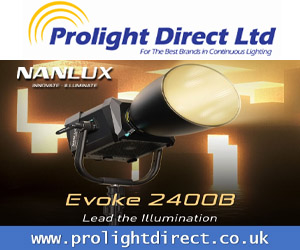Broadcast News
20/05/2015
A Brief Guide To Choosing Picture Monitors...

15 years ago, buying a CRT picture monitor was simply a case of buying the latest version of your favourite brand in either Grade I or II. The advent of the LCD, HDTV and the demise of the CRT means we have now to try and decipher all the marketing jargon to work out which display best fits our needs, writes Steve Hathaway, Managing Director, High Performance Media.
To help de-mystify the process, here are some guidelines that'll stand you in good stead when trying to decide what you need. Firstly, as a principle, always buy one 'level' above what you think you need as having a good quality picture monitor will always impress clients and, in a competitive world, it separates 'the men from the boys'. Don't be a 'cheap skate' and buy a TV for less important monitoring as televisions are designed for a different purpose and give over saturated colours with accentuated detail and higher brightness. From a practical perspective, you need to know if the HD-SDI signal is good or otherwise, particularly in a world with so many signal formats and increasing complexity of cameras and their respective sensors. Picture quality is king in monitors and you'll get to know the 'look and feel' of your (higher quality) monitors and therefore be able to make a judgement about the signal just by looking at the screen.
Monitors for different applications
In a production environment, ruggedness can be as important as functions and facilities; after-all, you don't want to be caught out in the middle of a field miles from anywhere not having the right connectivity or perhaps even being able to check signal level on a waveform. For editing you need a monitor that you can rely upon to tell you whether the material that you're editing is good enough. A grade 2 level monitor might suffice unless you are also doing grading when there's no substitute for a high quality, grade 1 display. In an OB or SNG, the whole purpose of camera racking is to make sure that your camera is set up correctly, which includes colour and detail so a grade 1 is essential and preferably a 1920x1080 resolution with a minimum size of 21.5", so you can see detail.
In an engineering area, it really depends upon the quality of racking monitors and how much you can trust them as to the quality of engineering monitors. Essentially, a grade 2 minimum, but preferably a grade 1 as picture stability is often better in grade 1s and they are less prone to 'drift'. For this application it is useful to have signal format display, a colour waveform monitor, vectorscope, audio meters (with selectable scale) and time code display so that you can check a wide range of parameters of the signal. Some monitors can show two pictures simultaneously, called PIP or PAP, which is useful to monitoring a programme output and an off air signal together. In a production gallery, picture quality is very important too and you wouldn't want rows of monitors giving different colours, for example.
The trend for OBs in mainland Europe is to go for high quality reference monitors with a colour calibration facility which allows operators to ensure that all monitors have the same, accurate colours. Whilst these monitors are initially more expensive they are much better value as they last twice as long (7-8 years instead of 3-4 years) and directors and producers like to see true quality picture for their productions.
Interoperable television standards
The technical standards for monitoring are prescribed by the EBU and are set out in documents EBU TECH 3320 and EBU 3325 which are available online. These set out the guidelines for broadcast grade 1, grade 2 and grade 3 broadcast LCD displays whilst ITU-R Recommendation BT.709, more commonly know by the abbreviations Rec. 709 or BT.709, sets out standards for colourimetry. Theoretically, everyone in the industry should be working to these standards to ensure interoperability.
LCD and OLED technologies
LCD technology is a mature +10 year old technology, with panels available in all sizes from 1" to +80". OLED technology is relatively new, still 'bedding in' and available in limited sizes and has quite different display characteristics to LCD. Most home TVs use LCD technology and by using LCD for picture monitoring removes one potential problem from the production process. LCD gives a 'truer' broadcast picture with more accurate black details whilst the OLED gives super crisp, high contrast/colour pictures with blacks deeper than you get even at the darkest parts of this planet.
Research has established that OLED picture monitors can degrade colours quickly and the overall life cycle is much shorter than LCD technology. They are not recommended for use with multiviewers, in-vision UMDs as well as long term use with safe area markers as they suffer from 'burn-in'. Whilst OLEDs monitors have become widespread, user experience suggests that they are not a panacea and very careful consideration needs to be given to the application to which they are used.
Choosing a picture monitor
The choice of picture monitors is ever increasing and can become bewildering, especially as there is quite a variation in quality. Using the 'mass market' brands means that you're mostly going to get 'middle of the road' performance. It is worth spending some time finding specialist companies like High Performance Media Technology Solutions who develop their own displays and work with some of the best monitor manufacturers in the world. They have an enormous range incorporating over 70 different models so, not only do you get more choice but more appropriate monitors which more often than not, do more and cost less.
(JP)
To help de-mystify the process, here are some guidelines that'll stand you in good stead when trying to decide what you need. Firstly, as a principle, always buy one 'level' above what you think you need as having a good quality picture monitor will always impress clients and, in a competitive world, it separates 'the men from the boys'. Don't be a 'cheap skate' and buy a TV for less important monitoring as televisions are designed for a different purpose and give over saturated colours with accentuated detail and higher brightness. From a practical perspective, you need to know if the HD-SDI signal is good or otherwise, particularly in a world with so many signal formats and increasing complexity of cameras and their respective sensors. Picture quality is king in monitors and you'll get to know the 'look and feel' of your (higher quality) monitors and therefore be able to make a judgement about the signal just by looking at the screen.
Monitors for different applications
In a production environment, ruggedness can be as important as functions and facilities; after-all, you don't want to be caught out in the middle of a field miles from anywhere not having the right connectivity or perhaps even being able to check signal level on a waveform. For editing you need a monitor that you can rely upon to tell you whether the material that you're editing is good enough. A grade 2 level monitor might suffice unless you are also doing grading when there's no substitute for a high quality, grade 1 display. In an OB or SNG, the whole purpose of camera racking is to make sure that your camera is set up correctly, which includes colour and detail so a grade 1 is essential and preferably a 1920x1080 resolution with a minimum size of 21.5", so you can see detail.
In an engineering area, it really depends upon the quality of racking monitors and how much you can trust them as to the quality of engineering monitors. Essentially, a grade 2 minimum, but preferably a grade 1 as picture stability is often better in grade 1s and they are less prone to 'drift'. For this application it is useful to have signal format display, a colour waveform monitor, vectorscope, audio meters (with selectable scale) and time code display so that you can check a wide range of parameters of the signal. Some monitors can show two pictures simultaneously, called PIP or PAP, which is useful to monitoring a programme output and an off air signal together. In a production gallery, picture quality is very important too and you wouldn't want rows of monitors giving different colours, for example.
The trend for OBs in mainland Europe is to go for high quality reference monitors with a colour calibration facility which allows operators to ensure that all monitors have the same, accurate colours. Whilst these monitors are initially more expensive they are much better value as they last twice as long (7-8 years instead of 3-4 years) and directors and producers like to see true quality picture for their productions.
Interoperable television standards
The technical standards for monitoring are prescribed by the EBU and are set out in documents EBU TECH 3320 and EBU 3325 which are available online. These set out the guidelines for broadcast grade 1, grade 2 and grade 3 broadcast LCD displays whilst ITU-R Recommendation BT.709, more commonly know by the abbreviations Rec. 709 or BT.709, sets out standards for colourimetry. Theoretically, everyone in the industry should be working to these standards to ensure interoperability.
LCD and OLED technologies
LCD technology is a mature +10 year old technology, with panels available in all sizes from 1" to +80". OLED technology is relatively new, still 'bedding in' and available in limited sizes and has quite different display characteristics to LCD. Most home TVs use LCD technology and by using LCD for picture monitoring removes one potential problem from the production process. LCD gives a 'truer' broadcast picture with more accurate black details whilst the OLED gives super crisp, high contrast/colour pictures with blacks deeper than you get even at the darkest parts of this planet.
Research has established that OLED picture monitors can degrade colours quickly and the overall life cycle is much shorter than LCD technology. They are not recommended for use with multiviewers, in-vision UMDs as well as long term use with safe area markers as they suffer from 'burn-in'. Whilst OLEDs monitors have become widespread, user experience suggests that they are not a panacea and very careful consideration needs to be given to the application to which they are used.
Choosing a picture monitor
The choice of picture monitors is ever increasing and can become bewildering, especially as there is quite a variation in quality. Using the 'mass market' brands means that you're mostly going to get 'middle of the road' performance. It is worth spending some time finding specialist companies like High Performance Media Technology Solutions who develop their own displays and work with some of the best monitor manufacturers in the world. They have an enormous range incorporating over 70 different models so, not only do you get more choice but more appropriate monitors which more often than not, do more and cost less.
(JP)
Top Related Stories
Click here for the latest broadcast news stories.
10/07/2024
Ikegami Announces New Additions To Its Broadcast Quality Picture Monitors
Ikegami has announced two new additions to its range of broadcast quality picture monitors: the 24-inch HLM-2460WA and 18.5-inch HLM-1860WR. These wil
Ikegami Announces New Additions To Its Broadcast Quality Picture Monitors
Ikegami has announced two new additions to its range of broadcast quality picture monitors: the 24-inch HLM-2460WA and 18.5-inch HLM-1860WR. These wil
27/11/2008
Oxygen DCT's IPS-LCD Picture Monitors Wow Visitors At Anydefinition.tv
Visitors from broadcasters and post houses were wowed by the image quality of the IPS-LCD picture monitors from UK-based equipment manufacturer and di
Oxygen DCT's IPS-LCD Picture Monitors Wow Visitors At Anydefinition.tv
Visitors from broadcasters and post houses were wowed by the image quality of the IPS-LCD picture monitors from UK-based equipment manufacturer and di
12/01/2009
New Dual Picture-In-Picture DVI-I Scaler From TV One
A specialist in video, audio and multimedia processing equipment, TV One, will introduce the new 1T-C2-750 Dual Picture-in-Picture DVI-I Scaler at the
New Dual Picture-In-Picture DVI-I Scaler From TV One
A specialist in video, audio and multimedia processing equipment, TV One, will introduce the new 1T-C2-750 Dual Picture-in-Picture DVI-I Scaler at the
10/03/2009
Sony Expands Line Of LCD Professional Monitors With New Nine-Inch Display
Sony's family of professional LCD displays is expanding to include the new LMD-940W 9-inch widescreen model (viewable area measured diagonally). With
Sony Expands Line Of LCD Professional Monitors With New Nine-Inch Display
Sony's family of professional LCD displays is expanding to include the new LMD-940W 9-inch widescreen model (viewable area measured diagonally). With
27/01/2020
Marshall Lynx Monitors – High Quality For The Budget Conscious
Representing a great array of choices for those on a budget and available in various screen sizes, Marshall Lynx Monitors offer an economic price poin
Marshall Lynx Monitors – High Quality For The Budget Conscious
Representing a great array of choices for those on a budget and available in various screen sizes, Marshall Lynx Monitors offer an economic price poin
21/06/2006
Ten Years Up - Total Audio Offer Prizes Of Top Quality Monitors And Headphones
UK pro-audio experts, distributors and equipment supplies specialists, Total Audio Solutions are 10 years old this year - and to celebrate, the latest
Ten Years Up - Total Audio Offer Prizes Of Top Quality Monitors And Headphones
UK pro-audio experts, distributors and equipment supplies specialists, Total Audio Solutions are 10 years old this year - and to celebrate, the latest
11/09/2000
TEKTRONIC ENHANCE PROGRAMME QUALITY OF SERVICE MONITORS
Tektronix, Inc. developers of Video Quality of Service (VQoS) products, have enhanced their latest version of the PQM300 Programme Quality of Service
TEKTRONIC ENHANCE PROGRAMME QUALITY OF SERVICE MONITORS
Tektronix, Inc. developers of Video Quality of Service (VQoS) products, have enhanced their latest version of the PQM300 Programme Quality of Service
16/01/2014
Sony Launches HD LCD Monitors
Sony has launched new HD multi-format LCD monitors. The new models consist of the LMD-A240 (24-inch, 1920x1200), the LMD-A220 (22-inch, 1920x1080), an
Sony Launches HD LCD Monitors
Sony has launched new HD multi-format LCD monitors. The new models consist of the LMD-A240 (24-inch, 1920x1200), the LMD-A220 (22-inch, 1920x1080), an
06/09/2012
Chromatec Release High-Quality 16 Channel In-Picture Audio And Video Meter
Chromatec, a leading developer of audio level metering products has released a fully-featured, in-picture audio level and video metering product as pa
Chromatec Release High-Quality 16 Channel In-Picture Audio And Video Meter
Chromatec, a leading developer of audio level metering products has released a fully-featured, in-picture audio level and video metering product as pa
27/08/2009
Tektronix Picture Quality Analyzer 'Proves A Winner'
A top worldwide provider of test, measurement and monitoring instrumentation, Tektronix, Inc. has announced that Fnac Laboratories has selected the co
Tektronix Picture Quality Analyzer 'Proves A Winner'
A top worldwide provider of test, measurement and monitoring instrumentation, Tektronix, Inc. has announced that Fnac Laboratories has selected the co
12/08/2009
Range Of LCD Monitors At IBC 2009 From TV One
TV One are showing their full range of LCD monitors at the up-coming IBC 2009 exhibition being held in Amsterdam. The monitors are available in a wide
Range Of LCD Monitors At IBC 2009 From TV One
TV One are showing their full range of LCD monitors at the up-coming IBC 2009 exhibition being held in Amsterdam. The monitors are available in a wide
11/03/2009
Sony Expands Line Of LCD Monitors For High-End Broadcast And Video Production
Sony is expanding its line of TRIMASTER LCD monitors for critical evaluation and broadcast video production with two new models. The PVM-L2300 23-inch
Sony Expands Line Of LCD Monitors For High-End Broadcast And Video Production
Sony is expanding its line of TRIMASTER LCD monitors for critical evaluation and broadcast video production with two new models. The PVM-L2300 23-inch
03/02/2009
Vaddio Debuts New PreVIEW HD Dual And Triple LCD Rack Mount Monitors
Vaddio, a leading manufacturer and OEM distributor of speciality PTZ cameras and high-end camera control systems used in the broadcasting, audio/visua
Vaddio Debuts New PreVIEW HD Dual And Triple LCD Rack Mount Monitors
Vaddio, a leading manufacturer and OEM distributor of speciality PTZ cameras and high-end camera control systems used in the broadcasting, audio/visua
19/01/2009
Argosy Introduces New LCD HD Video Monitors At BVE 2009
Following extensive evaluation, Argosy, a leading international supplier of HD broadcast, cables and studio infrastructure products, has added a new L
Argosy Introduces New LCD HD Video Monitors At BVE 2009
Following extensive evaluation, Argosy, a leading international supplier of HD broadcast, cables and studio infrastructure products, has added a new L
16/10/2008
Oxygen DCT Introduces Evolution Pro-Plus LCD Monitors With Added Simulation
UK-based broadcast equipment manufacturer and distributor Oxygen DCT has just launched the Evolution Pro-Plus LCD monitors with added stimulation. Ext
Oxygen DCT Introduces Evolution Pro-Plus LCD Monitors With Added Simulation
UK-based broadcast equipment manufacturer and distributor Oxygen DCT has just launched the Evolution Pro-Plus LCD monitors with added stimulation. Ext















